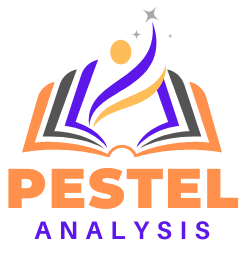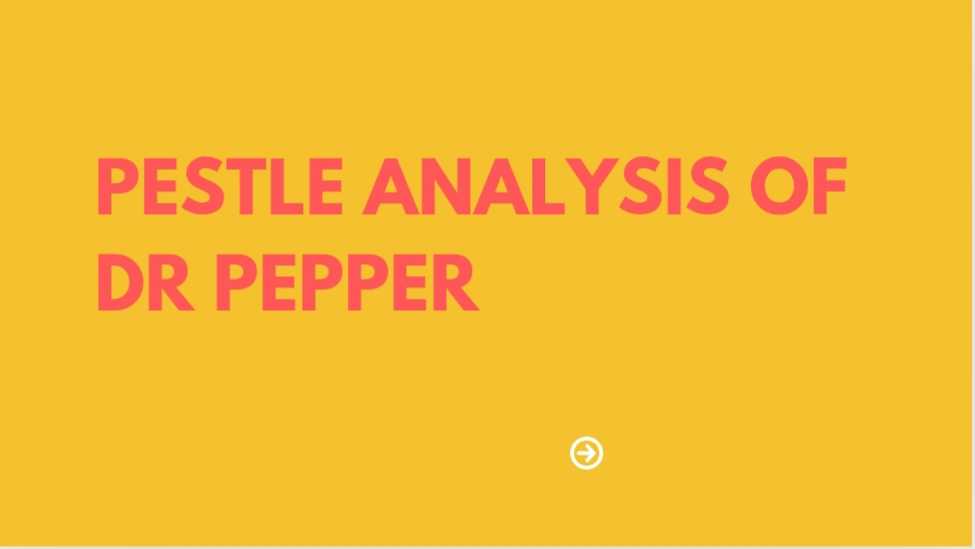The purpose of this Microsoft Pestle Analysis is to provide an insight into the company’s business situation and management decisions and strategies, as well as its core business operations. It has been suggested that the PESTLE analysis can be used as a tool to identify the external factors which are influencing remote or macro-environments in which firms operate.
The external factors in Microsoft’s case reflect the performance of the computer hardware, software, consumer electronics, and cloud computing markets. Factors such as these are relevant to the company’s operations. Microsoft can develop competitive, resilient strategies by including these issues determined through the PESTLE analysis.
Introduction To Microsoft Pestle Analysis
Based on the conditions of Microsoft’s remote or macro-environment, this PESTEL/PESTLE analysis reveals the company’s most significant issues. According to the PESTEL analysis, Microsoft can implement strategies that address the information technology and online services market’s issues and corresponding external factors
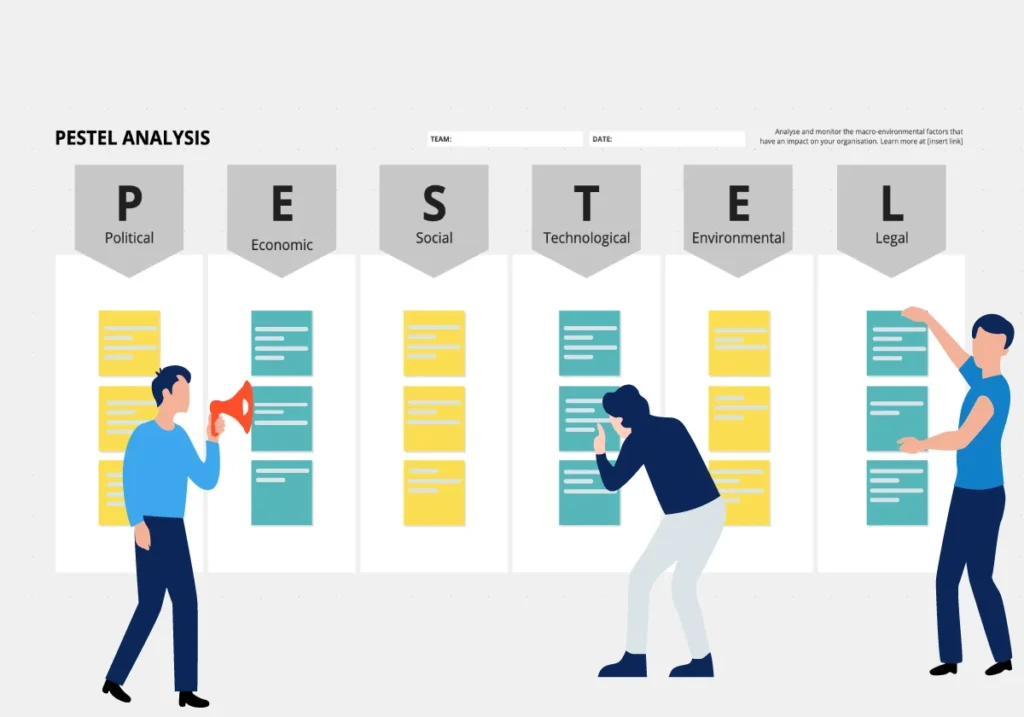
Microsoft Business Segments
There are three primary segments in Microsoft’s business:
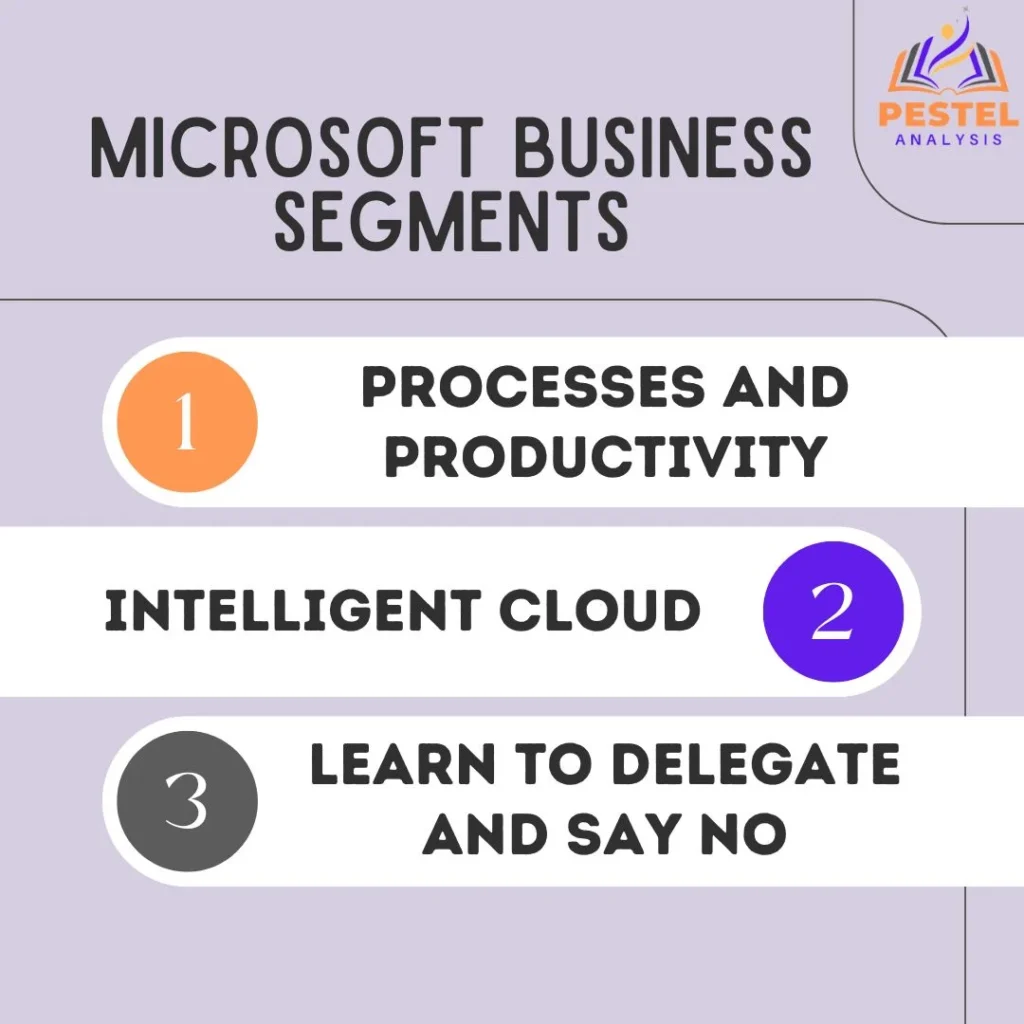
Processes and productivity
Information services, communication services, and productivity products are included in this segment. In addition to Office Commercial, which includes Office 365 subscriptions, Office Consumer, which includes Office 365 Consumer and Microsoft 365 Consumer subscriptions; and LinkedIn, it also includes Dynamics business solutions, including Dynamics 365.
Intelligent Cloud
In this segment, we have public, private, and hybrid server products and cloud services, including SQL Server, Windows Server, Visual Studio, System Center, and related CALs, GitHub, and Azure. Besides developing, deploying, and managing these software solutions, it also provides consulting and support services.
PC Personalization
IT professionals, developers, and end-users are all served by products and services in this segment.
Microsoft Windows, including OEM licensing as well as non-volume licensing of the Windows operating system, Microsoft Windows Commercial, which includes volume licensing of the Windows operating system, Microsoft Cloud Services and other Microsoft commercial services, as well as Surface, Xbox, including Xbox hardware and content and services, Search advertising, and Display advertising.
Through its cloud-based services, Microsoft’s software, platforms, and infrastructure are available to a broad range of users. Through continuous innovation and strategic acquisitions, it has positioned itself as a leading technology company.
With its diverse software, hardware, and services portfolio, and an increasing focus on cloud-based solutions, Microsoft aims to empower every individual and every organization on Earth to achieve more.
Microsoft’s Pestle Analysis: Scope and Purpose
It is more than just surfacing problems for Microsoft when it comes to PESTLE analysis. In order to maintain leadership in technology innovation, it is a strategic tool. This analysis has the following scope and purpose:
| Scope | Purpose |
| Evaluation of the global market | Making informed decisions |
| Management of risks | Planning for the future |
| Growth areas to be identified | Allocation of resources |
Microsoft’s business is affected by political factors
The PESTEL analysis model considers the impact of governments on the computer hardware and software industry’s remote and macroenvironments. In this case, Microsoft’s strategic decisions are influenced by the following political factors:
Microsoft has the opportunity to increase its investments and corresponding performance in most markets across the globe due to the political stability of most countries. A corresponding increase in revenue can be achieved by improving the company’s sales and marketing investments in Europe. Microsoft, on the other hand, can increase its sales of computer technology and consumer electronics to governmental clients as government support for automation increases. Regarding large-scale purchases made by governmental organizations, this external factor is significant in the context of the PESTLE analysis. Additionally, increased international trade agreements support an increase in Microsoft’s global sales as a result of a remote or macro-environment.
Microsoft’s Technological Factors
PESTLE analysis examines the effects of technologies on the computer technology and online service industry’s macroenvironment. As part of its technological strategy, Microsoft should integrate the following factors:
Mobile device innovation can help Microsoft improve its performance. Mobile technology is increasing in popularity and adoption, which creates this opportunity. In this PESTEL analysis, such an external factor facilitates Microsoft’s competition with such an external factor. A market like this could be exploited by more technology companies. Meanwhile, Microsoft can develop more products to support secure online transactions due to the growing volume of online transactions.
Microsoft’s Ecological/Environmental Factors
The ecological impact of computer hardware and software industry issues on the economy is considered in this component of the PESTLE analysis. As a result of its remote or macro-environment, Microsoft is exposed to the following ecological factors:
Microsoft can enhance its sustainability standing by offering green products to customers. In its business operations, like its datacenters, for example, the company can increase the use of green energy and produce environmentally friendly products. Microsoft’s efforts to improve its sustainability are directly in line with the PESTEL analysis’s sustainability opportunity, which relates to the increased focus on business sustainability among societies. In addition, the company can expand its use of recycled materials in its packaging and computer hardware products by increasing the availability of recyclable materials. In this part of Microsoft’s PESTEL analysis, opportunities are presented by the macro-environment. Consumer electronics, online services, and IT growth are all opportunities beyond direct business growth.
Microsoft’s Economic Factors
This component of the PESTEL analysis examines how economic conditions affect computer hardware, software, and consumer electronics. The following economic factors must be considered by Microsoft:
Most developed countries have considerable economic stability, which benefits Microsoft. IT, consumer electronics, and online services markets will provide stable business performance for the company. High-growth markets in developing countries can also boost Microsoft’s sales revenue. In the context of a PESTLE analysis, this opportunity corresponds to Microsoft’s steady growth in global sales. The company also benefits from the external factor of the overall rise in middle-class disposable income worldwide. A significant portion of Microsoft’s revenue comes from middle-class customers. As highlighted in this economic component of the PESTLE analysis, a company can strategically address such opportunities.
| Current Economic Situation | Microsoft’s impact |
| Growth of the economy | Increased demand |
| The economic downturn | Decreased demand |
Microsoft’s social factors
Specifically, this PESTEL analysis examines how Microsoft’s business environment is impacted by the social and cultural situation, especially in terms of customer behavior and expectations. Microsoft is influenced by the following social factors in the information technology market:
Microsoft can develop leisure-related products that can satisfy customers’ leisure preferences by taking advantage of the stable attitudes toward leisure. To achieve this goal, the company could invest more in innovative video gaming products. This PESTLE analysis concludes that Microsoft’s remote or macro-environment is at risk from increasing cultural diversity in terms of mismatches between products and customers. Due to the company’s products satisfying only the largest cultural groups, customer satisfaction could decrease. Microsoft still has an opportunity to address this issue by improving its goods and services. Meanwhile, the company has an opportunity to enhance its customer support activities due to the stable demand for high-quality customer service.
The external factors in Microsoft Corporation’s PESTLE analysis focus on opportunities for growth. IT, consumer electronics, and online services are affected by sociocultural variables that shape employees’ perceptions and behaviors. This impacts the company’s ability to develop products that match those variables.
Aspects of the law that affect Microsoft’s industry
This component of the PESTLE analysis determines the business significance of laws and regulations. Legal factors in Microsoft’s business environment impact strategic success in the following ways:
Increasing electronic waste disposal regulations present Microsoft with an opportunity to improve brand image by implementing more effective recycling and disposal programs. In addition, this PESTEL analysis considers a legal factor as an additional threat that can further complicate the company’s efforts to address its environmental impact. By reducing issues, such as computer software piracy, better patent laws facilitate Microsoft’s growth globally.
With more energy-efficient computing technologies, the company can also enhance its products to help clients reduce their energy consumption. The macro-environment of Microsoft is a growth opportunity based on this component of the PESTEL analysis.
Microsoft’s Pestle: Strategic Insights
Competitive Advantage Through Analysis
The PESTLE analysis from Microsoft provides valuable insights for gaining a competitive advantage. To understand how PESTLE impacts the business, it is essential to understand each element.
Political factors
Microsoft’s operations can be affected by government policies and regulations.
Economic factors: Economic factors like growth rate, inflation rate, and unemployment rate affect business revenue.
Sociocultural factors
These are the changing tastes and preferences of consumers that influence the development of products.
Technological factors
Due to Microsoft’s position in the technology industry, it is essential to stay on top of new technologies and innovations.
Legal factors
Microsoft, like all businesses, must adhere to the law. It is important to be aware of legal constraints so that litigation can be avoided.
Environmental factors
Microsoft should take measures to reduce its carbon footprint and consider its interaction with the environment.
Strategic Planning for Long-Term Success
We can now apply these insights to developing long-term strategies after understanding the elements of PESTLE.
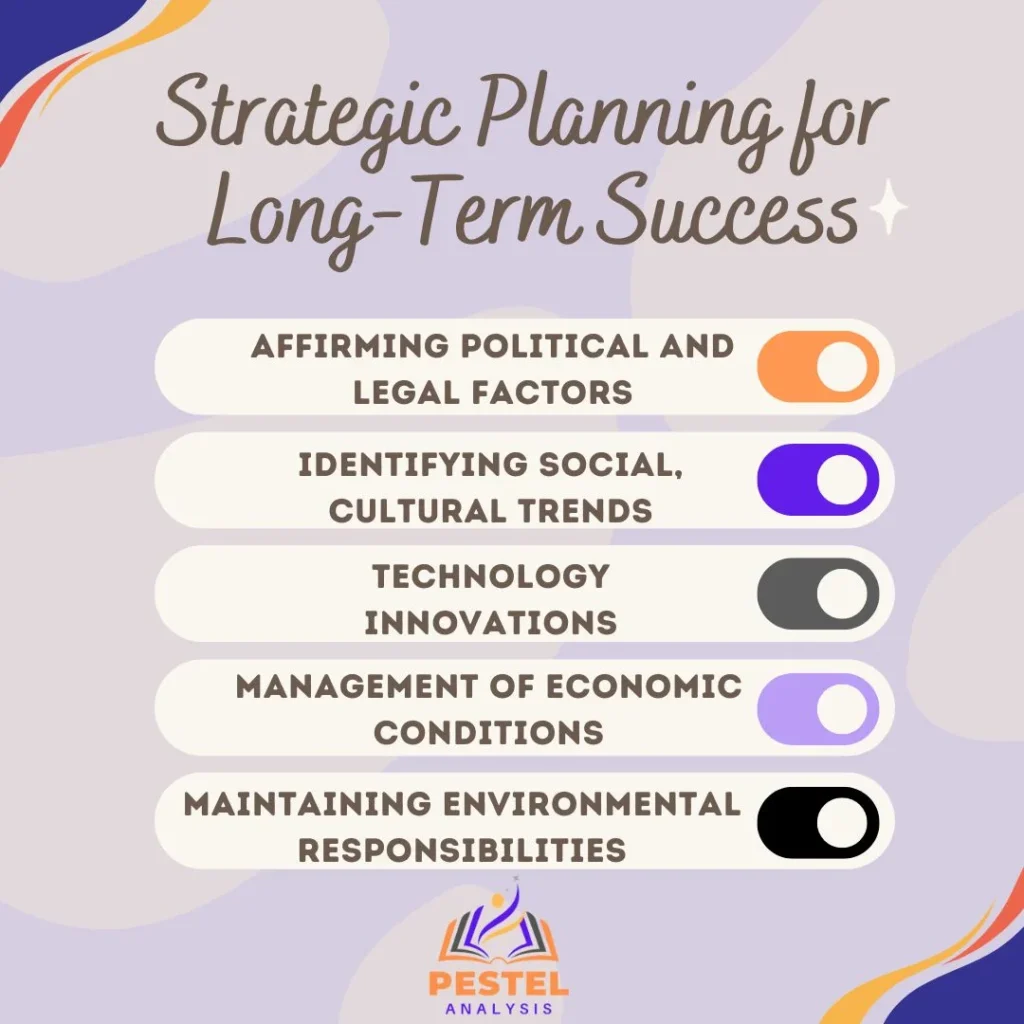
Affirming Political and Legal Factors
Microsoft can make strategic adjustments to its operations based on changes in government policies and regulations.
Identifying Social, Cultural Trends
Microsoft develops new products that satisfy customers’ needs by identifying societal trends and consumer behavior.
Technology Innovations
Through continuous research and development, Microsoft releases cutting-edge products.
Management of Economic Conditions
Microsoft is able to fine-tune its pricing strategies based on economic indicators such as inflation rate and market conditions.
Maintaining Environmental Responsibilities
Implementing green practices, reducing waste, and promoting Microsoft’s eco-friendliness will increase its brand image.
Microsoft’s Future Outlook
We should reflect on the prominent strengths and weaknesses of Microsoft’s PESTLE analysis as we conclude this guide. The report also includes several strategic recommendations as well as a look at future opportunities.

In terms of its external environment, Microsoft has several strengths and some weaknesses. Here’s what we have to say:
Strengths
Diverse product portfolio, strong technological infrastructure, and global brand awareness.
Weaknesses
Dependence on the PC market, security issues, and product failures.
Frequently Asked Questions
An overview of the Political, Economic, Social, Technological, Legal, and Environmental factors impacting a business is typically found in a PESTLE framework PDF. Planned and executed using it is a tool for strategic analysis.
There are six PESTLE components: Political, Economic, Sociocultural, Technological, Legal, and Environmental. An organization’s strategies and decisions are influenced by macro-environmental factors.
A PESTLE analysis considers factors related to politics, economics, social, technology, law, and the environment in the computer industry. The report identifies external factors affecting the performance of the industry. Business forecasting and planning are enhanced through this analysis of potential opportunities and threats.
Politics, Economics, Social, Technological, Legal, and Environmental influences affect a business according to the PESTLE analysis.
Conclusion
In order to navigate the complex business landscape dominated by Microsoft, it is important to understand Microsoft’s Pestle analysis. By leveraging these insights, you can make strategic decisions and plan for the future. It is often necessary in business to conduct such analyses to remain one step ahead of the competition.
